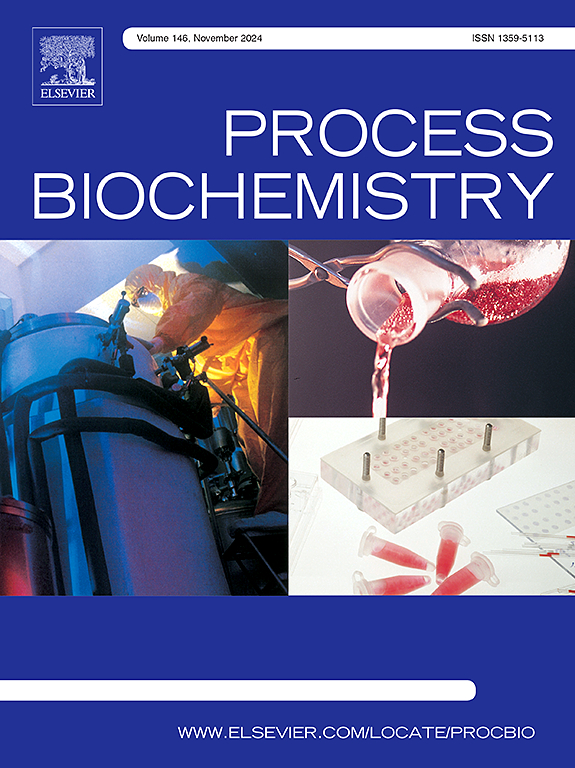脂肪、油和油脂(FOG)与羧酸结合的厌氧消化:沼气动力学、微生物组和代谢途径
IF 4
3区 生物学
Q2 BIOCHEMISTRY & MOLECULAR BIOLOGY
引用次数: 0
摘要
在厌氧消化(AD)中添加羧酸(C2和C3)可以刺激微生物生长,提高沼气产量。因此,随着脂、油、脂(FOG)浓度的增加,C2和C3分两相分别添加。研究了C2和C3对沼气和挥发性脂肪酸(VFAs)生成的影响。微生物群落在细菌和古菌之间的变化,以及代谢途径和功能酶也进行了研究。在第一期末,添加C2和C3后,FOG消化的产气量分别增加了1.69倍和1.47倍。VFAs和长链脂肪酸的积累限制了第二期的产气量。Clostridium(28.8 ~ 48.3 %)和Turicibacter(20.1 ~ 8.7 %)在C2和C3改性的FOG反应器中含量丰富。C3的添加也增加了假乳杆菌(27.5% %)和硫代假单胞菌(9.08% %)。C2和C3改性反应器中以甲烷菌为主,分别占79.1 %和84.6 %。预测的主要代谢途径为碳代谢(ko01200)和ABC转运蛋白(ko02010)。葡萄糖苷酶和辅酶F420氢化酶分别是细菌和古细菌中最重要的酶。添加羧酸可以有效地促进复杂底物(如FOG)的消化。本文章由计算机程序翻译,如有差异,请以英文原文为准。
Anaerobic digestion of fats, oils, and greases (FOG) combined with carboxylic acids: Biogas kinetics, microbiome, and metabolic pathways
The addition of carboxylic acids (C2 and C3) in anaerobic digestion (AD) can stimulate microbial growth and improve biogas production. Thus, C2 and C3 were added separately in two phases with an increasing fat, oil, and grease (FOG) concentration. The effects of C2 and C3 on biogas and volatile fatty acids (VFAs) production were studied. The microbial community shifts among bacteria and archaea were also examined, along with the metabolic pathways and functional enzymes. Biogas production during FOG digestion was increased by 1.69- and 1.47-fold upon the addition of C2 and C3, respectively, at the end of phase I. The accumulation of VFAs and long-chain fatty acids limited the biogas production in phase II. The Clostridium (28.8–48.3 %) and Turicibacter (20.1–8.7 %) were abundant in C2 and C3 amended FOG reactors. The addition of C3 also upsurged Pseudigracilibacillus (27.5 %) and Thiopseudomonas (9.08 %). Methanosphaera was the predominant archaea accounted for 79.1 % and 84.6 % in C2 and C3 amended reactors, respectively. The major predicted metabolic pathways were carbon metabolism (ko01200) and ABC transporters (ko02010). Glucosidase and coenzyme F420 hydrogenase were the foremost bacterial and archaeal enzymes, respectively. Digestion of complex substrates (such as FOG) could be effectively enhanced by the addition of carboxylic acids.
求助全文
通过发布文献求助,成功后即可免费获取论文全文。
去求助
来源期刊

Process Biochemistry
生物-工程:化工
CiteScore
8.30
自引率
4.50%
发文量
374
审稿时长
53 days
期刊介绍:
Process Biochemistry is an application-orientated research journal devoted to reporting advances with originality and novelty, in the science and technology of the processes involving bioactive molecules and living organisms. These processes concern the production of useful metabolites or materials, or the removal of toxic compounds using tools and methods of current biology and engineering. Its main areas of interest include novel bioprocesses and enabling technologies (such as nanobiotechnology, tissue engineering, directed evolution, metabolic engineering, systems biology, and synthetic biology) applicable in food (nutraceutical), healthcare (medical, pharmaceutical, cosmetic), energy (biofuels), environmental, and biorefinery industries and their underlying biological and engineering principles.
 求助内容:
求助内容: 应助结果提醒方式:
应助结果提醒方式:


